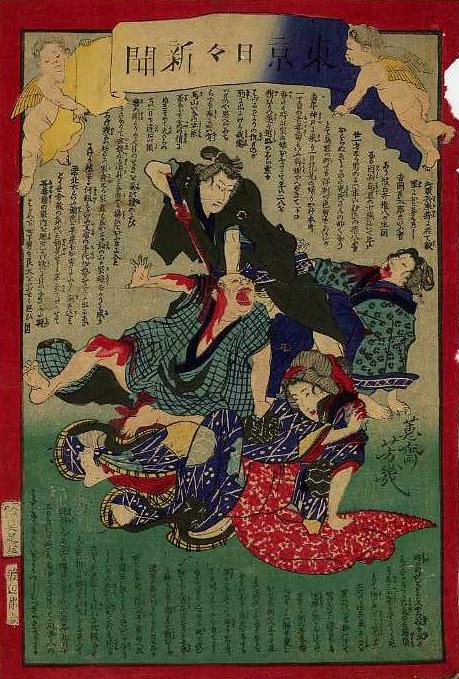Commentary"Shizoku" was a status created for former samurai who, when the domain they had been serving as a retainer became a prefecture, lost their entitlements and had to survive on their own. When disencranchised, thus losing what for many had been a birthright source of livelihood, such men recieved a small stipend to help set up a business or otherwise survive. "last year"There is no issue number on the banner and no source for the story, which is unsigned, has been not been found in Tonichi. But the Cherubs are Stage 2, which suggests that the print was published no earlier than October 1874. And Yoshioka is said to have been executed on "the 13th day of the 9th month of last year". A few early Stage 2 prints have lag times of more than one year, so it is very possible that the print was published between October and December 1874 in reference to an incident that took place during the summer of 1873 -- justice would have been swift in such a case. But because lag times appear to sharply shrink from Stage 2, I am provisionally assuming that the print was published early in 1875 in reference to a 1874 incident. If the manner in which the date of the story is declared at the end can be taken as a signature of the writer, then perhaps this story was written by Tentendō (Takabatake Ransen). For comparisons, see TNS-1036a Man nets thief and TNS-1054 Confessions of evil. "Ofusa [Ofuki]"The first mention of the woman's name is clearly "Ofusa" -- though the second mention is clearly "Ofuki", and the third and forth mentions also appear to be "Ofuki". Takahashi 1986 transcribes only the first half of the story but gives "Ofusa" for both mentions in that half. The descriptive blurbs in both Tsuchiya 1995 and Tsuchiya 2000 say "Ofusa". But the transcription of the text on Tsuchiya 2000 (and the same transcription in CCMA 2008) render all four mentions as "Ofuki". (WW) Print informationSize oban Principal sourcesYosha Bunko |

